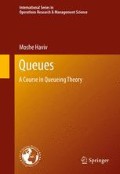Abstract
Consider a first-come first-served single-server queue. Assume that service requirements are independent and follow an identical exponential distribution with a parameter μ. This assumption implies that during a (not necessarily continuous) period of time of length t, the number of customers possibly served by the server has a Poisson distribution with parameter μt. The reason we use the term “possibly” is that in practice what can happen is that during that period or part of it, the system might be empty and hence, although service is ready to be provided, there is no one there to enjoy it. One more thing to observe here is that if one stops the clock when the server is idle, then the departure process under the new clock is a Poisson process. As always, the interarrival times have some continuous distribution with a density function denoted here by g(t) for t ≥ 0 and that they are independent. In other words, the arrivals form a renewal process. Finally, we assume independence between the arrival and the service processes.
Access this chapter
Tax calculation will be finalised at checkout
Purchases are for personal use only
References
Fakinos, D. (1982). The expected remaining service time in a single server queue. Operations Research, 30, 1014–1018.
Haviv, M., & Kerner, Y. (2010). The age of the arrival process in the G/M/1 and M/G/1 queues. Mathematical Methods of Operations Research, 73, 139–152.
Author information
Authors and Affiliations
Rights and permissions
Copyright information
© 2013 Springer Science+Business Media New York
About this chapter
Cite this chapter
Haviv, M. (2013). The G/M/1 Queueing System. In: Queues. International Series in Operations Research & Management Science, vol 191. Springer, New York, NY. https://doi.org/10.1007/978-1-4614-6765-6_7
Download citation
DOI: https://doi.org/10.1007/978-1-4614-6765-6_7
Published:
Publisher Name: Springer, New York, NY
Print ISBN: 978-1-4614-6764-9
Online ISBN: 978-1-4614-6765-6
eBook Packages: Business and EconomicsBusiness and Management (R0)

